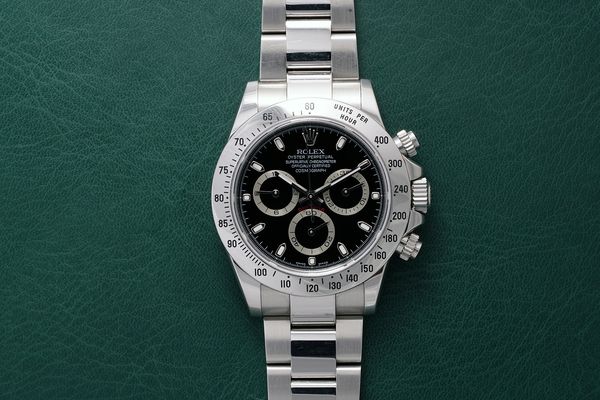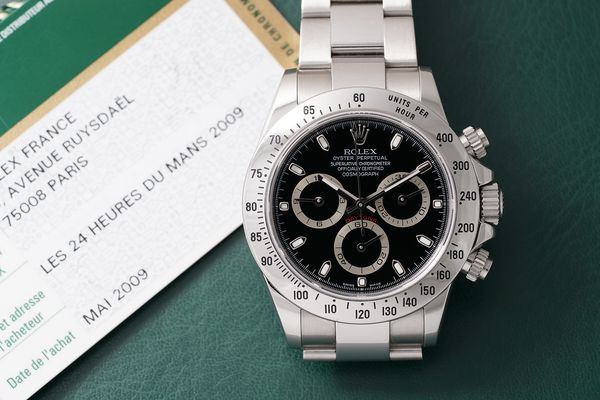By Arthur Touchot
I think it's fair to say the "The Winner" is not the first watch that comes to mind when reviewing the line-up of Daytona Ultimatum, an auction dominated by extremely rare vintage watches. The model itself, reference 116520 (of which "The Winner" is an example), is neither especially rare, nor is it vintage. But you'd be making a huge mistake by ignoring this particular example.
The Reference 116520 is a fairly recent Daytona which you could still purchase from Rolex as recently as two years ago. Introduced in the year 2000, the model replaced the Reference 16520, presenting a new case design and perhaps more importantly, a new COSC-certified movement made from beginning to end inside Rolex's manufacture. This was Rolex's first in-house chronograph movement and it impressed both in terms of precision and accuracy.
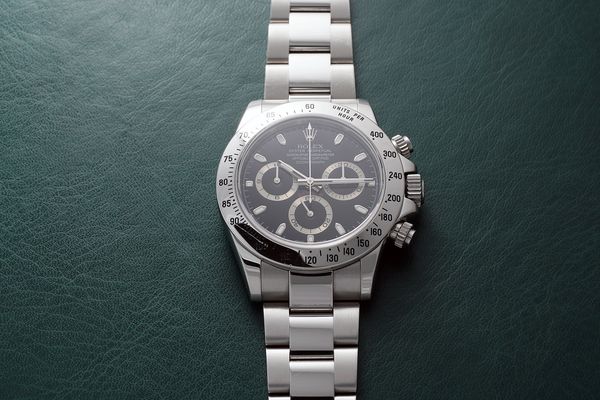
It is therefore an important member of the Daytona family, marking the manufacture's entry into the 21st century (literally), with a big introduction on the mechanical side and several changes to the watch's graphic layout, including the re-positioning of the subsidiary seconds from 9 o'clock to 6 o'clock. This was a decidedly modern Rolex, with a manufacture-made movement which ensured the company was no longer dependent on suppliers tobramp up the production of the Daytona. And that's exactly what they did.
The Reference 116520 was produced en masse between 2000 and 2016, making it one of the most universally enjoyed Daytonas and in the process, establishing the chronograph as a modern icon. Even though its production had been limitied, its availability on the secondary market – especially when compared to other Daytona models – means this particular watch probably wouldn't excite most vintage Rolex collectors. If you walked into a meet-up with this particular example on the wrist, most observers would at first glance mark you down as a casual fan, probably relatively new to watches. Of course, they'd be dead wrong because you would almost certainly be the one with the most unattainable Daytona in the room. And that's because "The Winner" comes with an engraving at the back which cannot be bought.
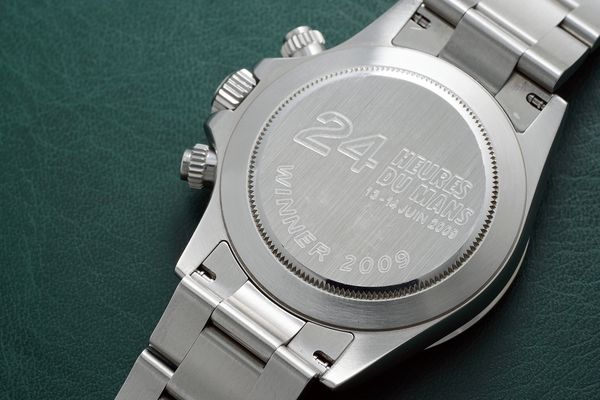
Rolex has been unwavering in its support for motorsports, proudly proclaiming its commitment to auto racing throughout the 20th and 21st century. In fact, when it was launched in 1963, the original Oyster Cosmograph was briefly known as the "Le Mans", before the company's push into the growing American market led to the adoption of the "Daytona" name, in honour of the 24 Hours of Daytona, of which it became an official sponsor. Rolex returned to Le Mans in 2001, becoming the race's official timekeeper and beginning a new tradition of offering Rolex Daytona watches to the winning team. David Brabham won his in 2009.
David Brabham was born in 1965 in Wimbledon, England. The son of Sir Jack Brabham, a three-time Formula One world champion, David himself competed in F1 between 1990 and 1994. But it was in endurance racing that he really shined. David won the Spa 24 Hours at his first attempt, in 1991, before podium finishes at the 12 Hours of Sebring in 1998 and 2003.
Brabham entered the 2009 edition of the 24 Hours of Le Mans as a member of the Peugeot Sport Total team, racing alongside Alexander Wurz and Marc Gené in the No. 9 car. This was Peugeot's third attempt at winning the race with the 908 HDi FAP, a diesel-engine sports car designed to compete with the Audi R10 TDI for Le Mans's Overall and Prototype Class standings.
Despite the German car's dominance in previous years – Audi claimed back-to-back victories between 2006 and 2008 – it was the French manufacturer who ranked top in qualifying, placing four cars in the first five positions on the grid, including an all-French team in pole.

Brabham and his teammates started fifth on the grid but quickly pulled themselves up the field, claiming the lead within the first two hours of the race, and controlling it with a faultless drive to beat the No. 8 car of Sebastien Bourdais, Franck Montagny and Stephane Sarrazin. The No.9 car would finish one lap ahead of its teammates’ to give Peugeot its first Le Mans win, sixteen years after David's brother, Geoff Brabham, gave them their last.
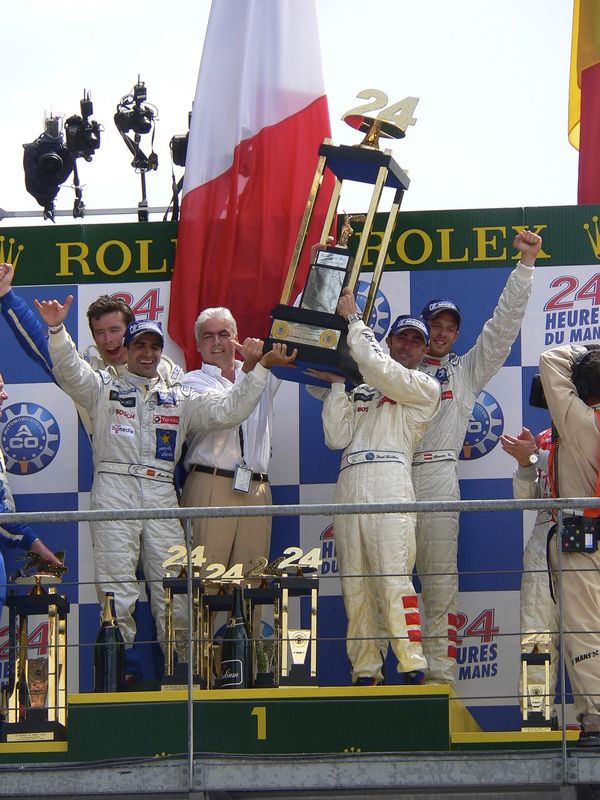
Marc Gené, David Brabham (middle) and Alexander Wurz lifting the trophy after the race. Credit: Wikimedia Commons.
This was a career defining victory; incidentally Peugeot's only win of Le Mans' modern-era endurance race (Audi would reassert control over the event before being bullied in recent years by Porsche). And for it he would receive one of the rarest and most desirable trophies in motorsports: a letter from Rolex addressed to ‘the winner’ and recipient of a brand new Rolex Daytona Reference 116520 with the words "WINNER 2009 24 Heures Du Mans" engraved on the case back.
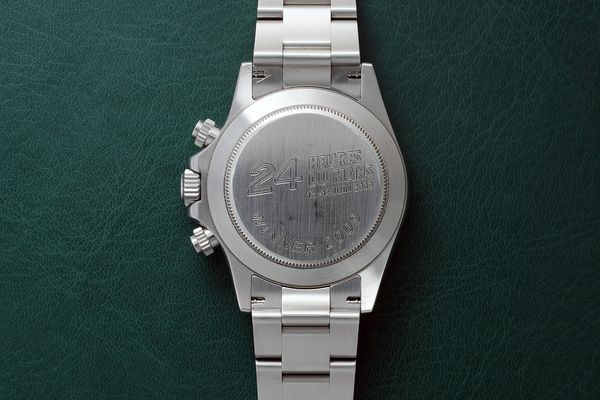
"The Winner" is Lot 25 of the Daytona Ultimatum auction, taking place on May 12 at the Hotel La Reserve in Geneva. It has an estimate of CHF 50,000 to CHF 100,000 and comes with a Rolex guarantee confirming the sale to Les 24 Heures du Mans 2009 in May 2009, Brabham's signed racing boots, and Rolex's letter to 'the winner'.
